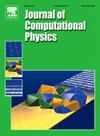Hydrodynamic cavitation with non-condensable gases: A thickened interface method with differentiable non-equilibrium thermodynamics based on van der Waals theory
IF 3.8
2区 物理与天体物理
Q2 COMPUTER SCIENCE, INTERDISCIPLINARY APPLICATIONS
引用次数: 0
Abstract
The van der Waals theory of phase transformations offers a fundamental framework for non-equilibrium thermodynamics of phase transforming fluids that can be coupled with flow using the Coleman-Noll procedure. Until recently, computations based on this modeling framework had been limited to very small length scales and low speed flows, but recent advances enable simulations at large Reynolds numbers and length scales. Here, we extend the van der Waals modeling framework and the enabling computational methods that were proposed for single-component fluids to a mixture of a phase-transforming fluid and a non-condensable gas. A key element of innovation in our approach is the development of an interface enlargement algorithm coupled with a stabilized numerical scheme that can robustly handle large density variations and remain stable in the non-hyperbolic region of the phase diagram. The accuracy, stability and robustness of the numerical method were verified through extensive numerical testing, including the use of theoretical and manufactured solutions as well as simulations of cavitating flow past a cylinder. Our simulations also show that the overall approach reproduces some of the experimental observations in cavitating flows with non-condensable gas in dissolution and in the form of nuclei, which underscores its potential to better predict and understand cavitating flows of mixtures.
不可冷凝气体的流体动力空化:基于范德华理论的可微非平衡热力学增厚界面法
范德华相变理论为相变流体的非平衡热力学提供了一个基本框架,可以使用Coleman-Noll过程与流动相结合。直到最近,基于这种建模框架的计算还局限于非常小的长度尺度和低速流动,但最近的进展使大雷诺数和长度尺度的模拟成为可能。在这里,我们将范德瓦尔斯建模框架和为单组分流体提出的使能计算方法扩展到相变流体和不可冷凝气体的混合物。我们方法创新的一个关键要素是开发了一种界面扩大算法,该算法与稳定的数值格式相结合,可以稳健地处理大密度变化并在相图的非双曲区域保持稳定。数值方法的准确性、稳定性和鲁棒性通过大量的数值测试得到验证,包括使用理论和制造的解决方案以及模拟空化流通过圆柱体。我们的模拟还表明,整体方法再现了一些在溶解不凝气体和以核形式存在的空化流动中的实验观察结果,这强调了其更好地预测和理解混合物空化流动的潜力。
本文章由计算机程序翻译,如有差异,请以英文原文为准。
求助全文
约1分钟内获得全文
求助全文
来源期刊

Journal of Computational Physics
物理-计算机:跨学科应用
CiteScore
7.60
自引率
14.60%
发文量
763
审稿时长
5.8 months
期刊介绍:
Journal of Computational Physics thoroughly treats the computational aspects of physical problems, presenting techniques for the numerical solution of mathematical equations arising in all areas of physics. The journal seeks to emphasize methods that cross disciplinary boundaries.
The Journal of Computational Physics also publishes short notes of 4 pages or less (including figures, tables, and references but excluding title pages). Letters to the Editor commenting on articles already published in this Journal will also be considered. Neither notes nor letters should have an abstract.
 求助内容:
求助内容: 应助结果提醒方式:
应助结果提醒方式:


